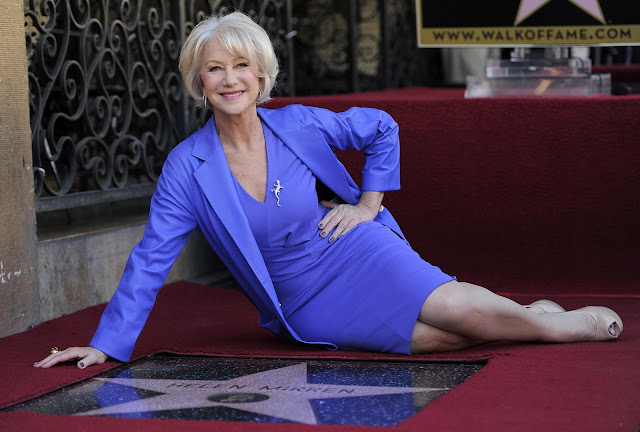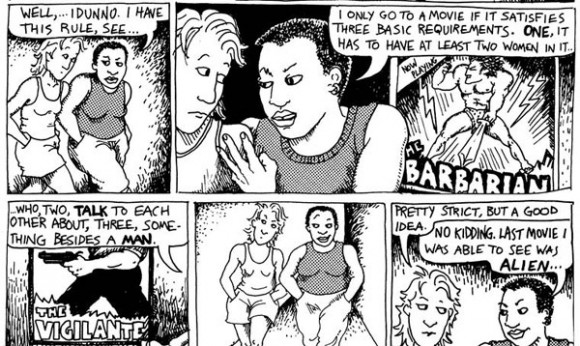 |
| The original Bechdel Test |
This piece by Magda Knight originally appeared at Mookychick and is cross-posted with permission.
A 1985 comic strip by US cartoonist Alison Bechdel, Dykes to Watch Out For, features a character who says they’d only go to see a movie on three conditions:
- The film has at least two named women in it
- Who talk to each other at some point in the film
- About something other than a man
The idea of the Bechdel Test caught on, and you can now visit the
Bechdel Test Movie List, a giant community-run resource that catalogues over 4,000 films which have women talking to each other about not-man things. I highly recommend you check out it out. Partly because it’s really interesting and eye-opening (
Straw Dogs just makes it), but mainly because you’ll see passionate and lengthy discussions of the merits of
My Little Pony: Equestria Girls and whether the lead females, being ponies, pass the test. AND OH, THEY DO. THE NATURAL ORDER OF THINGS IS RESTORED.
 |
| My Little Pony: Equestria Girls |
How do I feel about the validity of the Bechdel Test? My only reservation about it is that I think it’s terribly neat, and I fear tidy things because, as Erma Bombeck said, “My idea of tidy is to sweep the room with a glance.” Tidy is not something I demand of my hair, my house, my film theory or my beliefs. Tidy is rigid, and life ebbs and flows like a vast, floppy, wet and ultimately quite messy ocean teeming with potential and things with too many legs and other things, also with probably too many legs, all of which I’d honestly rather not have to tidy up. If you’re something with that many legs, you can tidy up after yourself. I’ll be on the sofa reading a book.
Einstein believed the universe would eventually boil down to just one universal constant, but I don’t even think art can be condensed into one neat little set of rules, however awesome they are. After all,
Fight Club is one of many excellent movies that fails the Bechdel Test, and I’m not going to harsh on Marla the Magnificent’s buzz for not talking to any women in the movie. Hot damn, Marla.
 |
| Helena Bonham Carter as Marla in Fight Club |
|
|
Bride Wars, on the other hand, gets a flying pass, and it’s a hideously cynical chick flick about two “best friends” who have sculpted their life ambitions around weddings. They discover they’re booked into the same hotel for a wedding on the same day and turn on each other like rabid dogs and dye each other’s hair blue without asking first because HEY THAT’S WHAT WOMEN BEST FRIENDS DO. The first rule of Fight Club is you don’t talk about Fight Club (unless it’s to gush about the wonderfully dark things it says about the human condition). The first rule of Bride Wars is, obviously, to just not watch it.
What I really do love about the Bechdel Test is the wonderful questions it encourages us to raise. I think it’s excellent for filmmakers and screenwriters to have in the back of their minds: Hey, wouldn’t it be nice if this film I’m creating had some women who talked to each other? Whose lives didn’t triangulate around men like bogeys on a radar screen?
 |
| Anne Hathaway and Kate Hudson in Bride Wars |
A study by the University of California looking at the 100 most successful box office films in 2012 found that just under 30% of the speaking roles were for women, and nearly 30% of those had revealing clothes, a figure which jumped to 56% for teenage girls. And never mind the clothes–how many of those speaking roles were for first or second billing, I wonder, and how many of them involved saying something other than, “We showed each other our private parts yesterday so let’s talk about where this relationship is headed, Dave,” or “Honey, of course you’ll make it through the robot jungle alive. I knitted you a robot handkerchief for good luck; now kiss me, you great big loveable robot fool”?
 |
| Helen Mirren |
2013 has been a particularly tricky and vocal year for women in films and visual entertainment:
- In March, Helen Mirren publicly criticised Sam Mendes for not including any women filmmakers in his list of inspirations and spoke out against the lack of women in the film industry when accepting her Empire Legend Award. BOOM.
- Professor Maggie Gale of the University of Manchester revealed to the Daily Telegraph that more plays were written by women in the Sufragette era than there are today.
- Thandie Newton told CNN how she’d been forced to have a movie camera stuck under her skirt as a teenager for a screen test. And how the resulting footage had been played to other people privately. Eurgh.
- Audrey Tatou (Amelie, The Da Vinci Code) told the Radio Times that she decided not to pursue a Hollywood career because she did not want “every single millimetre” of her body being scrutinised, because the Hollywood approach to an actress’s figure was “unforgiving.” If even Audrey Tatou feels she can’t aspire to be Audrey Tatou, what chance does a young female actress following in her footsteps have?
- It’s not just western cinema, either; Aruna Irani has spoken out against the lack of good roles for middle-aged women in Bollywood, saying, “There is no role for female characters, especially of my age group. Actresses like Hemaji, Rakhiji and Moushmiji, they all are just at home. And if sometimes they get the chance to be part of a film, then that is for three or four scenes.”
 |
| Audrey Tatou |
It’s almost a case of: if you’re a young and talented actress, you better make the most of those apples in your cheeks while you’ve still got them, apple-face, because only three women of your generation will get to be Maggie Smith or Helen Mirren, and you’re going to be expected to fight other actresses tooth and nail–almost as if you’d booked a wedding in the same place on the same day–to be one of them. And that percentage of women with speaking parts in film? The number’s been going down since 2009, not up. Speaking roles for women in film are currently at their lowest in five years.
Sony’s Amy Pascal, who ranks 14th on
Forbes‘ 20 Most Powerful Women in Business list, gave a really interesting interview on
closing the pay gap between men and women in Hollywood, and why women get paid less than men. I literally couldn’t figure out how to fit that into this article tidily (see above), so I’m just going to throw it in there. Enjoy!
 |
| Sony’s Amy Pascal |
If we take some positives from this…
- If you’re creating a film or play, consider the Bechdel Test. Could your script do with more speaking parts for women? Even older women? About non-man things?
- If you’re not creating a film or play but have always wanted to, give it a go. There are more Jane Campions and Kathryn Bigelows out there in the filmosphere, and one of them might be you.
- If you’re an actress, ALL POWER TO YOU. Things will be addressed, and they will get better. If it gets to the point where you’re giving an interview to CNN or accepting an Empire Legend Award? It’s not just acknowledgement for your talent and hard work, it’s a platform. If you speak out, people will hear you…
@MagdaKnight is the Co-Founding Editor of Mookychick. Her YA fiction and other writings have been published in anthologies and in 2000AD. She likes you already, so Email her and say hi, or visit her blog. She is on Google+.







